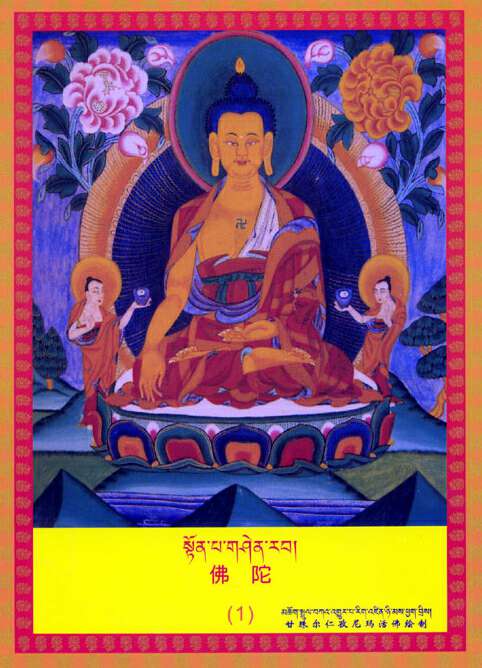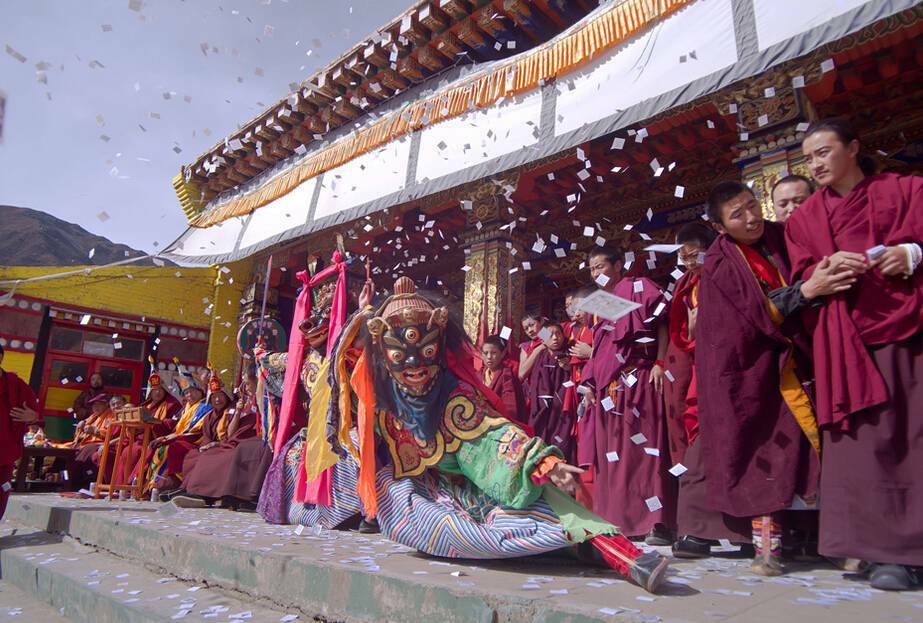Bon Religion in Tibet

Bon founder
According to the Bön religion, about 18,000 years ago Lord Tonpa Shenrab Miwoche (Founder of Bon and Great Man of the Shen Tribe) was born in the land of Olmo Lung Ring Tazik. “Öl” symbolizes unborn, “mo” implies undiminishing, “Lung” denotes the prophetic words of Tonpa Shenrab, “Ring” refer to his everlasting compassion, and “Tazik” indicates the region that scholars of the modern day recognize the present-day Tajikistan, which is situated north-west of Tibet that once thought to be the mythical kingdom called Zhang-Zhung (ShangShung in Tibetan). Olmo Lungring is also known as “Shambhala” in Sanskrit and it continues to be known by this name among Tibetan Buddhists even today.
At the age of thirty-one, he renounced the world and lived in austerity, teaching the dharma. During his whole life, his efforts to propagate the Bön religion were obstructed by the demon Khyabpa Lagring (Khyab-pa Lag-ring), that fought to destroy or impede Tonpa Shenrab’s work until eventually the demon was converted and became his disciple. Once while pursuing a demon to recover his stolen horses the Lord arrived in present-day western Tibet. This was his only visit to Tibet.
On this occasion, he imparted some instructions on the performance of rituals, but on the whole, he found the people unprepared to receive more teachings. Before leaving Tibet he prophesied that all his teachings would flourish in Tibet when the time was appropriate. Buddha Tonpa shed his human shell at the age of eighty-two. Admittedly 82 years in Olmo Lungring corresponds to some 8,200 years of human time.
There are three biographies of Lord Tonpa Shenrab. The earliest and shortest one is known as “Epitome of Aphorisms”; the second is in two volumes and is called “Piercing Eye”. These two accounts were rediscovered as Terma(Tibetan words literally meant to treasure) in the 10th and 11th centuries respectively. The third and largest is the twelve-volume work entitled “The Glorious”. This last book belongs to the category of Bon scriptures known as “Oral transmission”, and was dictated to Loden Nyingpo who lived in the 14th century.
Eighteen hundred years after the passing of Tönpa Shenrab, Mucho Demdug came from heaven to Olmo Lung Ring as the speech emanation of Tönpa Shenrab. Mucho Demdug turned the wheel of Bön so that all the teachings of Tönpa Shenrab would be organized and classified. He taught many students, the best known of which are referred to as the Six Great Scholars or the “Six Ornaments of the World”(Zamling Khepi Gyendug). They translated the Bön teachings into their own languages and spread them throughout their native lands. These six great masters are Mutsa Tahe, Tritok Partsa, and Huli Paryag from Tagzig; Lhadag Ngagdo from India; Legtang Mangpo from China; and Sertok Chejam from Trom.
Bon appearance in Tibet
The Bön teachings were by now well established in Zhang-Zhung. Zhang-Zhung was an independent state with its own language, literature, and culture. It was divided into three sections referred to as the “Three Doors”: inner (Phugpa), outer(Gopa), and middle (Barpa). The inner door is Olmo Lung Ring, the middle door is Tazik, and the outer door is Zhang Zhung itself.
The Bon doctrine is taught by Tonpa Shenrab and recorded in three accounts was spread by his disciples to adjacent countries such as Zhang-Zhung, India, Kashmir, and China, and finally reached Tibet. Its transmission was secured by Siddhas and scholars who translated texts from the language of Zhang-Zhung into Tibetan. The works contained in the Bonpo canon as we know it today are written in Tibetan, but a number of them, especially the older ones, retain the titles and at times whole passages in the language of Zhang-Zhung, therefore the teachings flourished throughout the ancient empire of Zhang –Zhung and it gradually brought to Central Tibet sometime before 600 A.D.
Since then it was also prospered in the Tibetan area until the emergence of Buddhism. Due in part to the nature of the narrative being slowly reshaped by the influence of Buddhism appearing in Tibet in the 7th century, the Bön religion itself has actually gone through three distinct phases: Animistic Bön, Yungdrung or Eternal Bön, and New Bön.
Many native Bon elements are obvious within Tibetan Buddhist rituals, and the New Bon of these days reflects Buddhist influence undoubtedly, though there remain many distinctions between these two religions, both share a common and ultimate commitment to the enlightenment of all sentient beings. Integral to the religious practice of Bön is a heightened sense of esthetics. Whether it be through the arts, philosophy, theology, mudras, mantras, ritual, dance, or astrology, examining, perceiving, and experiencing our intrinsic relationship to nature, and to the natural mind is an ever-evolving outspread of revelation and practice whose transforming mere existence into an experience of living with universal wisdom and compassion for all.
In the eighth century, the assassination of Emperor Ligmincha by the 38th Tibetan king Trisong Detsen ended Zhang Zhung’s independence. Thereafter, Zhang Zhung’s land and culture were assimilated into Tibet and eventually disappeared. However, many Zhang Zhung words from ancient Bön texts still exist in the modern languages of Kinnaur, Lahul, Spiti, Ladakh, Zanskar, and some Himalayan regions of Nepal.”
Currently, the practitioners of New Bon still honor the abbot of Menri monastery as the leader of their tradition

Bon Spirituality
As mentioned above, the Bon religion has gone through three distinct phases which include Old Bon, Yungdrung Bon, and New Bon. Yungdrung doctrine, otherwise known as Eternal Bon, is dedicated to perpetuating the teachings of their founder Tonpa Shenrab Miwoche, who occupies a preeminent position in Bon culture similar to that of Sakyamuni in Buddhism. The teachings and practice of Yungdrung Bon contain the Nine Ways or the Nine Gradual Views of Bon, the Four Portals and Treasure as the Fifth, and the External, Internal, and Secret Bon.
Bön was officially recognized by the Dalai Lama as the fifth wisdom school of Tibet in 1978.
1. Cha Shen Thegpa: the Way of Prediction – Describes the four methods of prediction; astrology, ritual examination of causes, and prophecy
2. Nang Shen Thegpa: the Way of the Visual World – explains the psychophysical universe, as relating to the origin and nature of gods and demons living in the world and the methodology of exorcism and the liberation of beings through energetic exchange
3. Trul Shen Thegpa: the Way of Illusion- rites for dispersing adverse powers
4. Si Shen Thegpa: The Way of Existence –describes the phases after death and the methods for guiding living beings toward final liberation
5. Ge Nyen Thepga: the Way of a virtuous layperson’s Path, offers ten principles of practice for well-being, and the practice of fasting
6. Drang Song Thegpa: the Way of Monk hood – explains the rules of monastic conduct and the first level of tantric practices
7. A Kar Thegpa: the Way of Pure A or Primordial Sound – elucidates higher tantric practices and the necessary rituals of visualization as well as the tantric practice of Che rim, explaining how to cut the bonds of rebirth, death, and the intermediate state
8. Ye Shen Thegpa: the Way of Primordial – expounds upon the essential reasons for having the appropriate master, place, and occasion for tantric practice and emphasizes the perfection tantric process Dzog rim, and obtaining the illusory body, Gyu lu.
9. La na me ba: the Unsurpassable Way – details the doctrine, views, meditation, and behavior of the Great Perfection, Dzogchen
